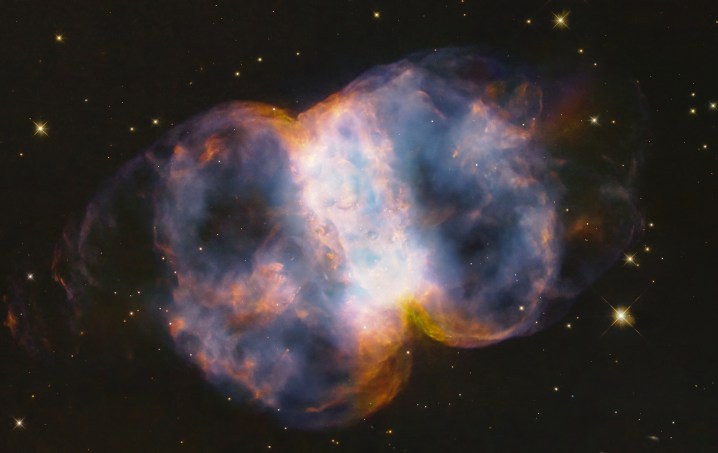Tomorrow, April 24, marks the 34th anniversary of the launch of the Hubble Space Telescope. For more than three decades, this venerable old telescope has been peering out into space, observing stars, galaxies, and nebulae to understand more about the universe we live in. To celebrate this birthday, Hubble scientists have shared a new image showing the striking Little Dumbbell Nebula, also known as Messier 76, which is located 3,400 light-years away.

The nebula takes its name from its double-lobed shape, with two regions of colorful gas glowing in a balloon-like structure that is pinched in the middle like a dumbbell. The shape is created by a star in the center, visible only as a white dot, which has come to the end of its life as a red giant and threw off layers of dust and gas. These layers traveled outward, creating the shell-like shape of each of the lobes. The gas glows because of ultraviolet radiation given off by the star in the center, which is one of the hottest stellar remnants known at an incredible 250,000 degrees Fahrenheit, or 24 times the surface temperature of the sun.
Scientists think that this dying star once had a companion star, which affected the way the shell of dust and gas developed. Although this companion is no longer visible, suggesting it may have been swallowed up by the red giant, it could have created a ring structure, which created the central pinch point of the lobes.
This beautiful structure won’t last for long, however, as the shells of dust and gas will fade over time and the nebula will disappear in around 15,000 years. To capture it while it’s still visible, Hubble used its Wide Field Camera 3 instrument to observe the object in five different wavelengths. That allows scientists to detect the presence of particular elements, with red in the image representing nitrogen, for example, and blue representing oxygen.
Editors’ Recommendations
Services Marketplace – Listings, Bookings & Reviews